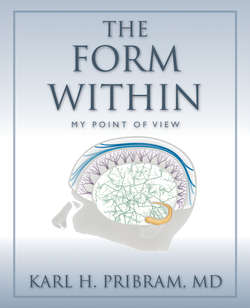Читать книгу The Form Within - Karl H Pribram - Страница 45
На сайте Литреса книга снята с продажи.
A Symposium in the Roman Tradition
ОглавлениеI was able to bring the attention of the neuroscience community to the issue raised during the encounter at MIT and to the spatial frequency formulation of visual receptive fields at a convention of the Society for Neuroscience held in Minneapolis (in the mid-1970s.) Mortimer Mishkin —a friend and former doctoral and postdoctoral student of mine during the 1950s—had, in his capacity of program chairman, asked me to organize a special symposium covering microelectrode studies in visual neuroscience. The symposium was to be special in that it would be held in the Roman tradition: the symposiasts arguing their respective views over flasks of wine!
The society was still of a manageable size (it has since grown to 36,000 members) and attendance at this particular symposium was restricted to an audience of 300. Wine and cheeses were served to all.
Symbolically (both from a political and a geographical standpoint) I placed Russell and Karen DeValois from the University of California at Berkeley to my left, and, to my right, Horace Barlow from Cambridge University and David Hubel from Harvard. Hubel, together with Torsten Wiesel, also of Harvard, had recently received the Nobel Prize for their work on “feature detection,” and I was pleased that he had graciously consented to participate in what was meant to be a challenging session.
I asked David to go last in our series of presentations, hoping that, if allowed to imbibe enough wine, he would be sufficiently mellow to welcome a discussion of any disagreements with his views on the neural substrate of perception. My plan worked.
Russell and Karen DeValois presented their data, which provided solid evidence for a frequency description of the pattern of receptive fields in the visual cortex. They also presented critical evidence against the formulation that line or edge detection of shapes best describes those receptive fields. Horace Barlow then presented evidence for how groups of cells in the brain extract a feature from the multiple features that characterize a visual scene, as opposed to the view that any single brain cell responds solely and uniquely to a particular feature such as a line.
Finally, I introduced David Hubel. In my introduction, I noted three things:
1 that David was a modest person, who would claim that he hadn’t understood the mathematical aspects of the DeValois presentation—but I would not let him get away with this because he had taught high school math before going to medical school;
2 that, in my experience, each cortical neuron encodes several features of our visual environment, that each neuron is like a person with many attributes, and thus our ability to recognize features had to depend on patterns displayed by groups of neurons for further processing;
3 that, as just presented, Karen and Russ DeValois had done critical experiments showing that the visual cortical cells were tuned to spatial frequency rather than to the shapes of “lines” or “edges.”
Hubel immediately announced to the audience, “Karl is right in everything he says about cortical cells, but I have never seen anything like what Russell DeValois is talking about.” Russ DeValois responded, “You are welcome to come to our laboratory at any time and see the evidence for yourself.” Hubel replied, “But I wouldn’t believe it if I saw it.” I chimed in, “David I didn’t realize you were a flatlander.” The symposium was on.
Hubel went on to point out that although cells might respond to many inputs, he was convinced they responded more to what he called a “critical sensory stimulus.” As a moderator I felt that I had said enough and didn’t challenge him on this, but as demonstrated in my laboratory and in many others, although his statement is correct for the receptive fields in further processing stations, (where the so-called “grandmother cells” are located) this characterization is incorrect for receptive fields in the primary sensory receiving cortex.
Hubel did admit that his views on feature detection had received little confirmation over the decades since he had first proposed them, but the identification of so-called “grandmother” cells that responded especially well to higher-order configurations, such as hands and (grandmothers’) faces, kept his faith in the feature detector view alive.
The audience and I felt amply rewarded by the exchange. Issues had been clearly engaged in a friendly and supportive fashion. This was science at its best.
Several issues had been aired. One, highlighted in Barlow’s presentation, is, of course, that feature extraction —as described earlier in this chapter by the metaphor of a show of hands—is eminently plausible but should not be confused with feature detection.
A second issue, highlighted by the DeValoises, and explored in the next chapter—sensory processing— involves the frequency domain.
